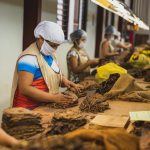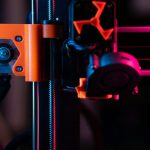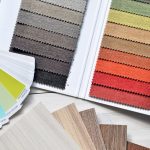Nonwoven fabric is a material made by bonding fibers together without weaving or knitting, giving you a lightweight, strong, and breathable fabric ideal for many uses. You’ll find it in hygiene products like masks and diapers, medical gowns, automotive interiors, and filters. Its quick production and durability make it a cost-effective alternative to traditional fabrics. If you want to explore how these fabrics impact various industries and their innovative applications, keep exploring further.
Table of Contents
Key Takeaways
- Nonwoven fabrics are made by bonding fibers through mechanical, thermal, or chemical methods without weaving or knitting.
- Key types include spunbond (durable), meltblown (fine filtration), and needle-punched (strong and flexible) nonwovens.
- They are lightweight, breathable, absorbent, and versatile, suitable for medical, hygiene, environmental, and automotive uses.
- Nonwoven fabrics offer cost-effective production, do not fray, and provide engineered uniformity for specific functional needs.
- Common applications include medical masks, wound care, disposable drapes, hygiene products, and filtration systems.
What Are Nonwoven Fabrics?
Nonwoven fabrics are materials made by bonding fibers together without weaving or knitting. When you use nonwoven fabrics, you’re working with textiles formed by directly connecting fibers through mechanical, thermal, or chemical means.
These fabrics don’t have the traditional thread structure you see in woven or knitted fabrics, which makes them unique. You’ll find nonwovens in everyday items like disposable wipes, medical masks, and filters because they offer properties such as durability, absorbency, and breathability.
Nonwovens lack traditional threads, making them ideal for durable, absorbent, and breathable everyday products.
Since they aren’t made by interlacing yarns, nonwoven fabrics can be engineered to meet specific performance needs, giving you flexibility in design and application.
Understanding what nonwoven fabrics are helps you appreciate their widespread use across industries, from healthcare to automotive.
How Nonwoven Fabrics Are Manufactured
You’ll find that nonwoven fabrics are made by bonding fibers together using several techniques like mechanical, thermal, or chemical methods.
Understanding the main production steps will help you see how these materials come to life efficiently.
Let’s explore how each bonding process shapes the final fabric.
Fiber Bonding Techniques
Although fibers can be arranged in various ways, they need to be bonded together to form a stable fabric. You’ll find that bonding techniques directly affect the strength, flexibility, and texture of nonwoven fabrics. The main methods include mechanical, thermal, and chemical bonding, each with unique advantages.
| Bonding Technique | Description |
|---|---|
| Mechanical | Entangles fibers physically |
| Thermal | Uses heat to fuse fibers |
| Chemical | Applies adhesives or binders |
| Hydroentanglement | High-pressure water jets |
| Needle Punching | Fibers interlocked by needles |
Production Process Steps
Once fibers are bonded using methods like mechanical or thermal techniques, the next step is to shape them into usable fabric through a series of production processes.
First, you’ll lay down the fibers evenly to create a web or batt. Then, depending on the bonding method, you might apply heat, pressure, or adhesives to secure the fibers together.
Some processes use needle punching or hydroentangling, where needles or high-pressure water jets interlock fibers for strength.
After bonding, you can finish the fabric by calendaring, which smooths or adds texture, or by coating for added properties like water resistance.
Finally, the nonwoven fabric is inspected, cut, and rolled for shipment. Each step guarantees the fabric meets your desired specifications and performance needs.
Types of Nonwoven Fabrics
Now that you understand how nonwoven fabrics are made, let’s explore the main types you’ll encounter.
You’ll see spunbond, meltblown, and needle-punched fabrics, each with unique properties and uses.
Knowing these types will help you choose the right fabric for your needs.
Spunbond Nonwoven Fabric
When you choose spunbond nonwoven fabric, you get a durable material made by bonding continuous filaments together without weaving or knitting. This process creates a strong, lightweight fabric that’s resistant to tearing and stretching.
You’ll find spunbond fabrics commonly used in medical masks, hygiene products, and agricultural covers because they offer excellent breathability and liquid repellency. Plus, they’re easy to produce in large quantities, making them cost-effective for many applications.
The fabric’s uniformity guarantees consistent performance, whether you’re using it for protective garments or packaging. Since it’s made from thermoplastic polymers like polypropylene, spunbond fabric is also recyclable, which helps reduce environmental impact.
Meltblown Nonwoven Fabric
While spunbond fabric offers strength and durability through continuous filaments, meltblown nonwoven fabric takes a different approach by using fine fibers created through a high-velocity air process.
This method produces ultra-fine fibers that form a dense, soft, and highly absorbent fabric. You’ll find meltblown fabrics excel in filtration, insulation, and medical applications thanks to their excellent barrier properties.
Because the fibers are so fine and randomly oriented, meltblown fabrics trap particles effectively, making them ideal for masks and air filters. They’re less strong than spunbond but offer superior filtration and softness.
When you need a nonwoven that combines fine filtration with comfort, meltblown fabric is often the best choice. Its unique structure gives it specialized functions that other nonwovens can’t match.
Needle-punched Nonwoven Fabric
Needle-punched nonwoven fabric stands out for its unique manufacturing process, where barbed needles repeatedly punch through layers of fiber to entangle them into a strong, durable web.
You’ll find this method ideal when you need a fabric that combines strength and flexibility without using adhesives or heat. This fabric’s robust structure makes it perfect for applications like geotextiles, automotive interiors, and filtration materials.
Since the fibers are mechanically bonded, the fabric maintains good permeability and cushioning properties. Plus, you can use a variety of natural or synthetic fibers, giving you versatility in texture and performance.
If you want a cost-effective, environmentally friendly option that withstands wear and tear, needle-punched nonwoven fabrics deliver exactly that.
Key Properties of Nonwoven Fabrics
Although nonwoven fabrics might seem simple at first glance, they offer a range of key properties that make them incredibly versatile for various applications.
Nonwoven fabrics may appear simple but possess versatile properties suitable for many different uses.
When you work with nonwovens, you’ll notice their unique combination of qualities that set them apart.
Here are some key properties you’ll find:
- Lightweight yet strong: They provide durability without added bulk.
- Breathability: Allow air and moisture to pass, ideal for comfort and hygiene.
- Absorbency: They can soak up liquids, useful in medical and cleaning products.
- Flexibility: Easily shaped or molded to fit specific uses.
Understanding these traits helps you choose the right nonwoven fabric for your project, whether it’s for industrial, medical, or consumer goods.
Advantages Over Woven and Knitted Fabrics
Because nonwoven fabrics are manufactured differently, they offer advantages over woven and knitted fabrics that you mightn’t expect.
You’ll find they’re typically more cost-effective since they require less complex production processes. Plus, they’re lightweight yet strong, making them ideal when you need durable material without added bulk.
Nonwovens also provide excellent uniformity and can be engineered for specific functions like filtration or absorbency, giving you tailored performance.
Unlike woven or knitted fabrics, they don’t unravel or fray, so you save time on finishing edges. Additionally, you can produce them quickly in large volumes, which benefits industries needing fast turnaround.
When you want versatility combined with efficiency, nonwoven fabrics give you a practical edge over traditional textile options.
Common Applications in Healthcare
You’ll find nonwoven fabrics in many healthcare essentials like surgical masks and gowns, which keep both patients and staff safe.
These materials also play a key role in wound care products, helping to speed up healing.
Plus, disposable medical drapes made from nonwovens maintain a sterile environment during procedures.
Surgical Masks and Gowns
Surgical masks and gowns rely heavily on nonwoven fabrics to provide effective barriers against bacteria, viruses, and fluids.
When you wear these protective items, nonwoven materials help keep you safe by filtering airborne particles and resisting liquid penetration. Their lightweight and breathable nature also guarantees comfort during long procedures.
You’ll find these fabrics designed to:
- Block pathogens with high filtration efficiency
- Repel blood and bodily fluids
- Offer durability without sacrificing flexibility
- Provide disposable options for infection control
Wound Care Products
Nonwoven fabrics don’t just protect you during surgeries; they also play an essential role in wound care products.
When you use dressings or bandages, nonwoven materials provide a soft, breathable barrier that helps wounds heal faster by keeping them clean and dry. These fabrics absorb fluids efficiently, reducing the risk of infection and promoting a comfortable healing environment.
You’ll find nonwoven fabrics in adhesive pads, gauze, and surgical tapes, all designed to offer secure yet gentle protection. Their lightweight and flexible nature means they conform well to different body parts, so you can move without irritation.
Thanks to their disposable nature, these products help maintain hygiene and prevent cross-contamination, making your recovery safer and more effective.
Disposable Medical Drapes
Disposable medical drapes create a sterile barrier that protects both patients and healthcare providers during procedures. When you use these drapes, you minimize the risk of contamination and infection by covering surrounding areas and equipment.
Nonwoven fabrics make these drapes lightweight, breathable, and fluid-resistant, ensuring comfort and safety throughout the procedure. You’ll find disposable medical drapes in various healthcare settings because they’re convenient and effective.
Here’s why you should rely on them:
- Prevent cross-contamination during surgeries
- Maintain a sterile field in diagnostic procedures
- Reduce cleanup time with single-use convenience
- Enhance patient and staff safety with barrier protection
Using disposable medical drapes helps you maintain hygiene while improving workflow in busy medical environments.
Use of Nonwoven Fabrics in Hygiene Products
Hygiene products rely heavily on nonwoven fabrics because they offer excellent absorbency, softness, and breathability. When you use items like diapers, sanitary pads, or wipes, nonwoven fabrics guarantee comfort and effective moisture management.
These fabrics wick away fluids quickly, keeping skin dry and reducing irritation. You’ll also find them in adult incontinence products, where durability and softness matter a lot.
Nonwoven fabrics quickly wick fluids, keeping skin dry and comfortable, perfect for adult incontinence products requiring durability and softness.
Nonwoven materials provide a lightweight, flexible structure that contours to the body, enhancing fit and protection. Plus, they’re disposable, making cleanup easy and maintaining hygiene.
Thanks to their versatility, nonwoven fabrics play an essential role in your daily hygiene routine, combining performance with comfort seamlessly.
Nonwoven Fabrics in Automotive Industry
Although you mightn’t notice them, nonwoven fabrics play an essential role in the automotive industry by enhancing comfort, safety, and durability.
These fabrics are integrated into various parts of your vehicle to improve performance and passenger experience. You’ll find nonwovens in areas where lightweight, strength, and noise reduction matter most.
Here’s how they’re used:
- Interior linings and headliners for sound absorption
- Seat cushions and upholstery backing for comfort and durability
- Insulation materials to improve thermal regulation
- Airbag components ensuring reliable deployment
Role in Filtration and Environmental Solutions
When you think about clean air and water, nonwoven fabrics play an essential role in filtration systems that protect both the environment and your health.
These fabrics efficiently trap pollutants, dust, and harmful particles, making them ideal for air filters in HVAC systems and face masks.
In water treatment, nonwoven materials filter out contaminants and sediments, ensuring safer drinking water.
You’ll find them used in industrial wastewater management, helping reduce environmental pollution.
Their durability and adaptability let you customize filters for specific needs, improving efficiency without sacrificing performance.
By incorporating nonwoven fabrics into filtration, you support sustainability efforts and promote cleaner ecosystems.
Their contribution to environmental solutions highlights their importance beyond everyday products, directly impacting global health and safety.
Emerging Innovations and Future Trends in Nonwoven Fabrics
As technology advances, nonwoven fabrics are evolving to meet new demands across industries. You’ll see innovations that enhance performance, sustainability, and versatility.
Manufacturers are focusing on creating smarter, eco-friendly materials that reduce waste and improve functionality. Here are some key trends shaping the future of nonwoven fabrics:
- Development of biodegradable and compostable fibers to minimize environmental impact
- Integration of nanotechnology for enhanced filtration and antibacterial properties
- Use of recycled materials to promote circular economy practices
- Smart textiles with embedded sensors for healthcare and wearable tech
Frequently Asked Questions
How Do Nonwoven Fabrics Compare in Cost to Traditional Textiles?
You’ll find nonwoven fabrics generally cost less than traditional textiles because they require less labor and time to produce. Their manufacturing process is more efficient, making them an economical choice for many applications.
Are Nonwoven Fabrics Recyclable or Biodegradable?
Think of nonwoven fabrics as the chameleons of textiles; some of them can be recycled or biodegrade, but it depends on their materials. You’ll want to check the specific fabric type to know how eco-friendly it really is.
What Safety Standards Regulate Nonwoven Fabric Production?
You’ll find nonwoven fabric production regulated by standards like ISO 9001 for quality, ASTM for material testing, and OSHA for workplace safety. Depending on use, FDA or REACH guidelines might also apply to guarantee safety and compliance.
Can Nonwoven Fabrics Be Dyed or Printed On?
Yes, you can dye or print on nonwoven fabrics, but the process depends on the fiber type and bonding method. You’ll want to choose suitable dyes and printing techniques to guarantee vibrant, lasting colors without damaging the fabric.
How Do Environmental Conditions Affect Nonwoven Fabric Durability?
Think of nonwoven fabric as a delicate dancer—extreme heat, moisture, or UV rays can wear it down faster. You’ll find its durability drops if you don’t protect it from harsh environmental conditions.
- What Is Percale Linen? Understanding This Unique Fabric Blend - July 14, 2025
- Are Percale Sheets Scratchy? What to Expect and How to Soften Them - July 14, 2025
- Are Percale Sheets Comfortable? A Guide for Different Sleep Preferences - July 14, 2025







